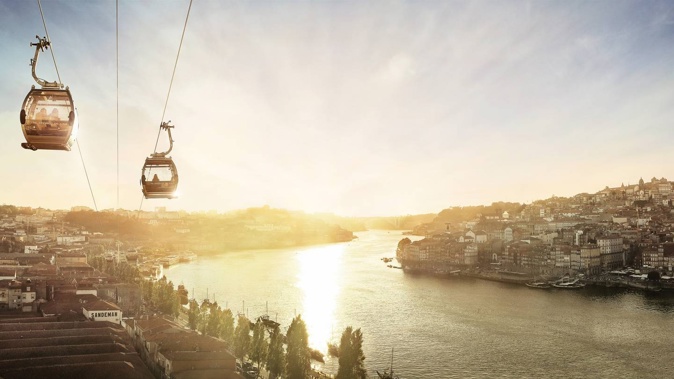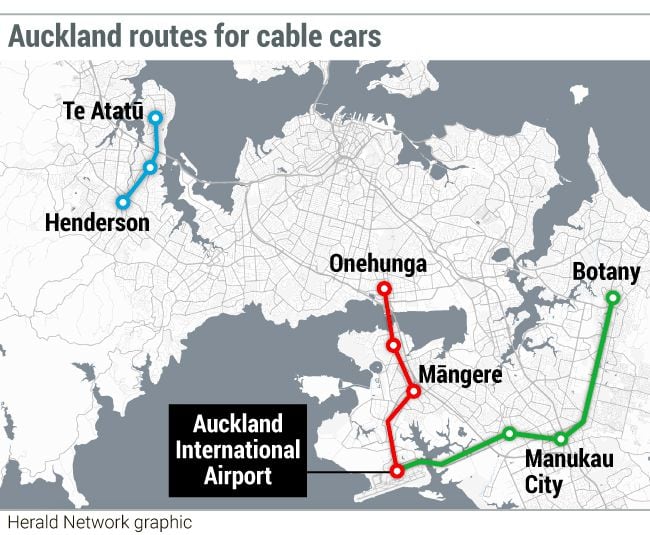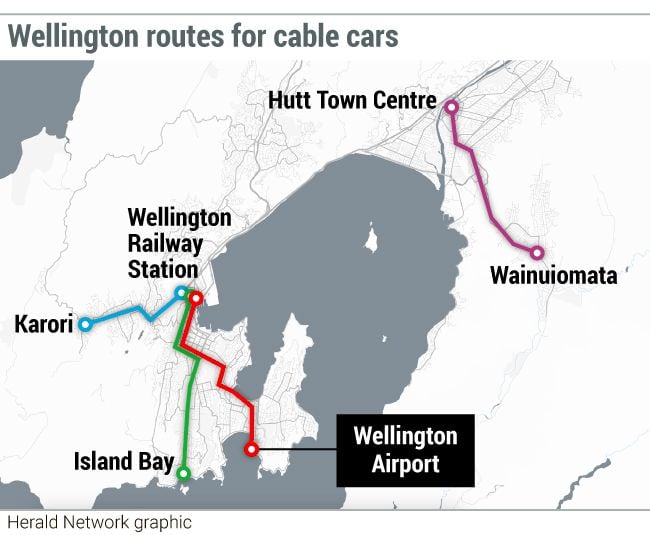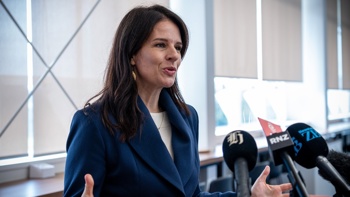
Aerial cable cars from Botany to the airport. Built within a couple of years for a fraction of the cost of light rail. With minimal disruption during construction and use. With a low-emissions footprint and a high fun factor.
Is this the transport solution congested Auckland has been waiting for?
The Austrian company Doppelmayr, which has a New Zealand base in Christchurch, thinks so. This morning it has released an Urban Transport Solutions Report, which it says “makes the case for urban cable car solutions in Aotearoa”.
The report identifies 10 routes in Auckland, Wellington and Christchurch which the company believes are a good fit for its cable-car technology.
They include two routes from the Auckland airport, to Botany and to Onehunga, four routes in Wellington and two in Christchurch.
The company wants “to partner with the appropriate planning and transport agencies to progress the investigation of these opportunities”.
“Doppelmayr’s experience is that aerial cable-car systems offer a range of benefits to urban environments under pressure from growth and increasing vehicle congestion, and while cities endeavour to meet ambitious climate targets,” says the company’s New Zealand chief executive Garreth Hayman.
“We have done extensive research with local experts to assess the feasibility of integrating aerial cable cars into New Zealand’s major cities.”
Doppelmayr has built aerial cable cars in cities in Europe, North and South America and Asia. It built the Skyline gondola in Queenstown and has worked with skifields worldwide, including in New Zealand.
Last year it proposed a cable-car line across the Waitematā, but seemed to generate little enthusiasm for the idea.
The company now says it is “open to exploring the potential for private/public financing or equity arrangements to facilitate the implementation of a suitable cable-car solution for New Zealand”.
/cloudfront-ap-southeast-2.images.arcpublishing.com/nzme/JQDS7AO6DNERBL2NPFSRXW7G5A.jpg) Doppelmayr's cable-car line in London.
Doppelmayr's cable-car line in London.
In Paris, Doppelmayr is building a 4.25km cable-car route with five stations. There’s one in London. In Bolivia, Mi Teleferico is a 33km network of 10 cable-car lines connecting the capital, La Paz, with a neighbouring city. In Portland, Oregon, a Doppelmayr cable car connects a major hospital on a hill with the city below.
The company says its system offers “direct, fast journeys” with 99.9 per cent reliability. Cars can arrive as frequently as every eight seconds, transporting several thousand people an hour.
“We know these solutions work because we have seen them in action in large international cities – where they complement existing transport networks and are incorporated into existing buildings, underground stations, airports and housing developments,” says Hayman.
Cabins are designed for roll-on access, making the service easy for wheelchair users, pushchairs and cyclists. And because they’re elevated, passengers get sweeping views across the city.
The system is electric, making it energy efficient. Towers can be spaced between 150m and 1km apart, depending on the terrain.
/cloudfront-ap-southeast-2.images.arcpublishing.com/nzme/3VVD3452SRFJNNHT6EDBSF6IYQ.jpg) Artist's impression of a cable-car station on the line now under construction by Doppelmayr in Paris.
Artist's impression of a cable-car station on the line now under construction by Doppelmayr in Paris.
Doppelmayr says construction costs are typically “a third of the construction cost of light rail or bus rapid transit and a tenth of metro”. Construction time is about two years.
The company says it has identified 20 “promising” sites for cable cars in Auckland, Hamilton, Tauranga, Wellington, Christchurch and Queenstown. The report, released this morning, names 10 of them.
Three are in Auckland: airport to Botany, airport to Onehunga and Te Atatū to Henderson.

In Wellington there are four: airport to central city, Island Bay to central city, Karori to central city and Wainuiomata to Hutt Valley.
For Christchurch, routes are proposed from Belfast and from the airport, both to the central city. In Queenstown, the company believes an airport-to-town-centre line is viable.

All three of the Auckland lines would provide an interchange with existing rail lines and busways. Airport passengers would have easy connections to the Southern and Onehunga rail lines and the Eastern Busway. Te Atatū residents could connect to the Western Express bus route and to the Western rail line at Henderson.
Doppelmayr says the cable cars could carry up to 3000 passengers an hour each way, depending on the route.
This is less than other rapid transit systems. The Northern Busway, for example, has carried as many as 8000 passengers per hour during the morning peak.
But Doppelmayr says its services would “complement” or provide “alternatives” to other services.
“World-class cities require world-class infrastructure and innovative, effective transport solutions,” says Hayman. “As part of an integrated network, aerial cable cars provide new possibilities by making use of the currently unused aerial level – one that is not hindered by other modes of transport.
“We are motivated by the opportunity to introduce public transport solutions in New Zealand that will complement, extend and fully integrate with existing train, bus and ferry services, as we have successfully done around the world.”
The company has not yet presented its proposal to the new Government, or to Auckland Mayor Wayne Brown and the transport agencies.
/cloudfront-ap-southeast-2.images.arcpublishing.com/nzme/K4MPED2QMNFB5OZ2TT242I22I4.jpg) Instituto De Desarrollo Urbano: A Doppelmayr cable-car line in Colombia.
Instituto De Desarrollo Urbano: A Doppelmayr cable-car line in Colombia.
Simon Wilson is a senior writer covering politics, the climate crisis, transport, housing, urban design and social issues, with a focus on Auckland. He joined the Herald in 2018.
Take your Radio, Podcasts and Music with you









